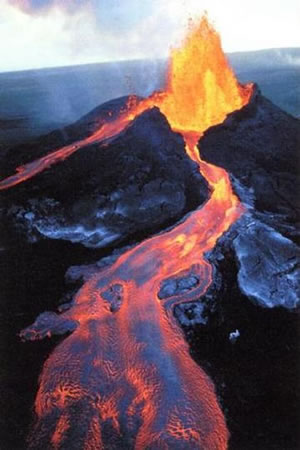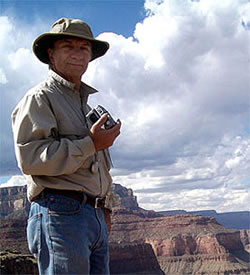Isotope Geochemistry: Deciphering Earth’s Cryptographic Notebook
By Lynn Yarris
If planet Earth can be characterized as an on-going experiment for which exceptionally good but cryptographically hidden notes have been kept, then isotope geochemistry can be thought of as the primary tool by which scientists decipher those notes. Through isotope geochemistry, scientists not only learn about the history and origin of the Earth, they can also discover the inter-relationships that have produced past climate change, explore for new sources of geothermal energy, investigate the interaction between water and underground rock, and even study the biological transformation of environmental contaminants.

Isotopes are atoms whose nuclei contain identical numbers of protons but different numbers of neutrons. Because of this slight difference in atomic mass, all isotopes of a given element display slight chemical differences which brands each with its own unique isotopic signature. Isotopes come in two varieties – stable and unstable. An unstable isotope is radioactive; through the emission of radiation, a radioisotope will break down or "decay" until it becomes a specific stable (non-radioactive) atom. The average rate at which the decay of a radioisotope takes place is characterized by its "half-life" - the time it takes for half of the atoms of the radioisotope in a sample to decay into a stable product. Since half-lives never change, scientists can use the ratio of a specific radioisotope to the stable isotope into which it decays as a sort of geological stopwatch. By measuring the concentrations of select radioactive and stable isotopes in rock or mineral samples, then comparing the ratios between them, scientists are able to calculate when the sample was formed and deduce as to how it was formed.
To measure isotope concentrations, scientists use a technique called “mass spectrometry.” Typically, a microsample of rock is dissolved in acid and elements of interest are separated via liquid chromatography. A miniscule amount of a single element, maybe no more than one ten-millionth of a gram, is deposited onto a special filament, inserted into a mass spectrometer, and vaporized. The constituent isotopes within that element are then ionized and focused into a beam which is directed through a magnetic field. The isotopes are sorted according to mass by the magnetic field and directed into detectors where their identity and concentrations can be determined.
Since just about every natural element is present in some quantity in all things, isotope geochemistry is the ideal tool for dating geological samples. The increment of time to be measured determines which isotope ratios are compared. For example, the most widely used of all radioisotopes is carbon-14, which decays to the stable nitrogen-14. With a half-life of 5,770 years, carbon-14 is perfect for dating biological materials and human artifacts, but not so good for tracking continental drift.
Geological dating calls for measuring much longer-lived radioisotopes, such as uranium-235 and uranium-238, with respective half-lives of 700 million years and 4.5 billion years, which is the age of Earth's oldest rocks.

Don DePaolo.
To develop and apply the tools of isotope geochemistry to the study of Earth’s geological history, the Lawrence Berkeley National Laboratory (Berkeley Lab) in collaboration with the University of California at Berkeley, and the National Science Foundation, established in 1999 the Center for Isotope Geochemistry. Under the direction of Donald DePaolo, a geologist who holds joint appointments with Berkeley Lab as director of its Earth Sciences Division, and UC Berkeley, where he is a geochemistry professor in the Earth and Planetary Science Department, researchers at the Center for Isotope Geochemistry have studied everything from tectonic plate drift, to comings and goings of Ice Ages, to volcanic activity. They’ve even applied isotope geochemistry to the study of meteorites that predate the earth.
"Everything about the study of isotope geochemistry is interconnected,” DePaolo says. “You can look at a lava flow in Hawaii and start to think about how the stars and planets formed billion of years in the past."
In recent years, researchers at the Center for Isotope Geochemistry have been applying their scientific techniques to energy-related studies such as geothermal systems and carbon sequestration. For example, Berkeley Lab geochemist Mack Kennedy, with Matthijs van Soest of Arizona State University, discovered that a high ratio of helium-three to helium-four isotopes in a fluid sample can point the way to new sources of geothermal energy that are associated not with volcanic activity but with the flow of surface fluids through deep fractures in the earth’s lower crust. And while the capture and storage underground of carbon dioxide could be a major avenue for the mitigation of climate change, scientists need a far better understanding of what will happen to the carbon once it is buried. Researchers at the Center for Isotope Geochemistry led by Kennedy and geochemist Mark Conrad have been studying the use of noble gas isotopes as natural tracers for monitoring the geologic sequestration of carbon dioxide.

The study of geologic sequestration of carbon dioxide recently received a huge boost when Berkeley Lab was named by the U.S. Department of Energy to host one of 46 new Energy Frontier Research Centers (EFRCs). The Center for Nanoscale Control of Geologic CO2 is slated to receive $20 million in funding for research that will primarily focus on learning more about the interaction between carbon dioxide and the pores inside underground rocks and minerals. The goal is to to efficiently fill pore spaces when rocks deep underground are injected with high-pressure carbon dioxide so that none leaks back into the atmosphere. DePaolo is also the director of this new EFRC facility.
“Investigators at the Center for Nanoscale Control of Geologic CO2 will probe the fundamental chemical, physical and biological processes that control the movement of carbon dioxide fluids in the earth,” he said when the award was announced this past April.
Additional Information
- For more about the Center for Isotope Geochemistry, visit the Web at http://www-esd.lbl.gov/CIG/index.html
- For more about the Center for Nanoscale Control of Geologic CO2, visit the Web at http://esd.lbl.gov/research/facilities/cncgc/
- For more about the Energy Frontier Research Center awards visit the Web at http://www.er.doe.gov/bes/EFRC.html
- For more about Berkeley Lab’s Earth Sciences Division, visit the Web at http://esd.lbl.gov/home/


